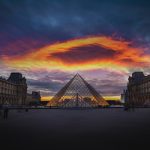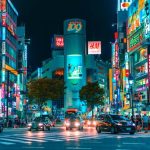Exploring Nguyen Duy Tri’s Artwork
Nguyen Duy Tri’s artistic talent is very compelling, as he continually pushes the limits of creativity and innovation. His ability to merge multiple techniques and styles flawlessly offers a one-of-a-kind visual experience for viewers. Tri’s painting transports us to a universe where the imagination knows no bounds.
Nguyen Duy Tri’s superb use of colour is one of his distinguishing features. Each stroke on the canvas appears purposeful and deliberate, with colours combining harmoniously to produce depth and emotion. Tri’s palette selections, whether vibrant or subtle, elicit strong sensations in the spectator, bringing each piece to life.
Nguyen Duy Tri’s art is also notable for its attention to detail. Each line, shape, and texture has been painstakingly designed to express a certain message or narrative. The accuracy with which he implements his ideas demonstrates not only his technical ability but also his commitment to storytelling via art.
Nguyen Duy Tri’s tremendous skill and relentless commitment to pushing artistic boundaries leave us in amazement with each new work. As we go deeper into the complexities of his paintings, it becomes clear that there is much more than meets the eye – hidden meanings and stories waiting to be revealed. This investigation of Nguyen Duy Tri’s craftsmanship contains a call for us all to embrace our own creativity and embark on self-expression journeys.
An Insight into Nguyen Duy Tri’s Last Sunshine: A Masterpiece
“No Feelings Nguyen Duy Tri • The Last Sunshine • 2022” by Nguyen Duy Tri is a compelling work of art that urges viewers to dig into its numerous levels of meaning. The artwork displays a setting soaked in warm hues and bright brushstrokes, showcasing Tri’s extraordinary talent and artistic vision. As one looks at this masterwork, it becomes clear that there is more to it than meets the eye.
At first look, “The Last Sunshine” appears to be a straightforward depiction of nature’s splendour. Closer inspection, however, reveals deeper concepts hidden into the artwork. Tri skillfully integrates symbolism throughout the piece, asking spectators to reflect on ideas like life cycles and the impermanence of existence. He creates an ambiance that induces both tranquillity and reflection through his superb use of colour and composition.
Furthermore, “The Last Sunshine” makes an important point about humanity’s relationship with nature. Tri emphasises human impact on the environment by juxtaposing components of man-made architecture against natural surroundings. This thought-provoking picture serves as a reminder to society about our obligation to preserve our world for future generations.
Uncovering the Themes of “The Last Sunshine”
Nguyen Duy Tri’s masterwork The Last Sunshine dives deeply into different subjects that appeal with audiences worldwide. One of the major themes covered in this artwork is the transience of existence and the transitory essence of time. Tri expresses the spirit of impermanence via his use of rich imagery and symbolism, telling viewers to treasure every moment.
Another recurring theme in “The Last Sunshine” is the investigation of human emotions and their intricacies. Through his brushstrokes and colour pallet, Tri depicts a variety of emotions such as joy, grief, love, and desire. Viewers experience empathy as they relate with the universal sensations expressed on canvas.
Furthermore, “The Last Sunshine” addresses societal themes such as environmental destruction and its consequences for humanity. Tri’s use of beautiful landscapes with slight indications of pollution is a strong reflection on our joint obligation to preserve our planet for future generations.
Overall, “The Last Sunshine” is a deep exploration of issues that are both timeless and present. Nguyen Duy Tri inspires viewers to reflect on their own lives while considering wider social challenges through his superb style and thought-provoking subject matter. As we explore deeper into the layers of meaning in this artwork, it becomes clear that there is much more to “The Last Sunshine” than meets the eye.
The Cultural and Historical Background of Nguyen Duy Tri’s “The Last Sunshine”
The historical and cultural background of Nguyen Duy Tri’s masterpiece “The Last Sunshine” is critical to comprehending the underlying themes and ideas portrayed in this masterpiece. The artwork, set against the backdrop of post-war Vietnam, illustrates the turbulent period of social and political transition that transpired during this time.
Vietnam was still rebuilding from years of violence, with physical and emotional scars left by the fighting. Tri’s artwork reflects the country’s ongoing process of rebuilding and reclaiming its identity. He highlights the paradox between hope and sorrow that pervades Vietnamese society through his use of vivid colours juxtaposed with sombre tones.
Furthermore, “The Last Sunshine” digs into Vietnam’s rich cultural past. Tri uses ancient symbols like lotus blossoms and conical caps to express persistence and solidarity in the face of adversity. These aspects serve as a reminder of Vietnam’s rich history while also demonstrating the country’s ability to adapt and evolve in changing times.
By delving into the historical backdrop of Nguyen Duy Tri’s “The Last Sunshine,” we acquire significant insights not only into his artistic objectives but also into the larger socio-political milieu in which it was made. This painting is a monument to both personal expression and community memory, enabling viewers to reflect on their own experiences and cultivating a greater understanding for Vietnamese culture.
The Symbolism and Imagery of “The Last Sunshine”
“No Feelings Nguyen Duy Tri • The Last Sunshine • 2022 is a masterwork that captivates spectators with its rich symbolism and imagery. The sunflower is one of the artwork’s most striking emblems, serving as a potent metaphor for hope and endurance. The vivid yellow petals indicate optimism and enthusiasm, while the sunflowers’ towering height represents strength and resolve. Tri urges us to consider our own ability to survive in difficult circumstances with this graphic representation.
Another important aspect of “The Last Sunshine” is the use of contrasting colours. The combination of warm tones like oranges and yellows with chilly blues generates a dynamic interplay that elicits emotions in the spectator. This contrast not only provides depth to the composition, but it also draws attention to ideas of duality and balance. It serves as a reminder that life is made up of both light and darkness, joy and sorrow.
Furthermore, Tri uses a variety of techniques to enhance his vision in “The Last Sunshine,” such as his precise brushwork, which adds texture and dimension to each stroke, producing a sense of movement within static settings. Furthermore, he effectively employs light and shadow to communicate various emotions throughout the artwork. Tri pulls viewers into his universe by meticulously adjusting these aspects, allowing them to fully immerse themselves in his artistic vision.
It is clear why “The Last Sunshine” is so significant in Nguyen Duy Tri’s body of work based only on its symbolism and imagery. Its profound examination of optimism through symbols such as sunflowers touches viewers from all walks of life. Furthermore, Tri demonstrates his technical prowess as an artist who understands how to generate emotion solely via visuals by masterfully employing contrasting colours and techniques that bring his images to life.
Nguyen Duy Tri’s Technical Brilliance: A Closer Look
The artistry of Nguyen Duy Tri is evident in his rigorous attention to detail and technical ability. Every brushstroke in his works demonstrates his ability to capture light, texture, and depth. The delicate nuances and lifelike aspect of his work cannot help but mesmerise.
Tri’s use of colour is really striking. He expertly blends colours to create a harmonic palette that gives vibrancy and life to his compositions. Tri’s command of colour provokes emotion and draws visitors into his universe, whether it’s the warm tones of a sunset or the cool blues of a tranquil coastline.
Tri also exhibits a strong sense of composition. Each element in his paintings is placed with care to achieve balance and visual intrigue. Every decision Tri makes, whether it’s the placement of persons or items within the frame or the arrangement of forms and lines, serves a purpose in boosting the overall effect of his artwork.
The Art World’s Reaction to “The Last Sunshine”
“The Last Sunshine” has a deep and far-reaching impact on the art world. With its distinctive blend of artistic approaches and thought-provoking subjects, Nguyen Duy Tri’s masterpiece has captivated audiences and reviewers alike. Tri has questioned conventional assumptions of what makes a piece of art by pushing the boundaries of established art mediums.
One distinguishing feature of “The Last Sunshine” is its capacity to cross cultural borders. The painting’s universal themes appeal with viewers from many backgrounds, allowing for a greater connection between the artwork and its audience. This cross-cultural appeal has contributed to Tri’s standing as an internationally famous artist, attracting attention and appreciation from all around the world.
Furthermore, “The Last Sunshine” has spurred crucial discussions concerning representation and social commentary within the art world. Tri addresses serious sociopolitical concerns such as environmental degradation, inequality, and cultural heritage loss through his use of symbolism and imagery. These powerful messages have led artists and researchers to consider their own work in relation to societal issues, resulting in a renewed emphasis on using art as a platform for activism.
Overall, “The Last Sunshine” has clearly had a big impact on the art world by defying conventions, uniting cultures, and generating important discourse. As future generations study and appreciate this masterpiece, it will definitely leave an indelible effect on both modern art practises and society at large.
The Socio-Political Commentary in “The Last Sunshine”
“The Last Sunshine,” Nguyen Duy Tri’s masterpiece, is a profound investigation of sociopolitical satire. Tri’s art dives into the complicated themes that affect society, shedding light to the challenges that individuals experience in the face of political persecution and social injustice.
One of the key topics of “The Last Sunshine” is the abuse of power and its consequences for ordinary people. Tri depicts scenes of corruption, violence, and inequality with vivid cinematography, pushing spectators to confront these unpleasant truths. The use of vivid colours with dark undertones creates a strong visual picture of the sharp contrast between hope and sorrow.
Tri’s artwork also serves as a heartbreaking reminder of the need of resisting repressive regimes. He represents those who refuse to be hushed or dominated by those in power. Their defiant attitudes and actions offer a strong sense of strength and drive to the viewer.
Nguyen Duy Tri’s thought-provoking sociopolitical commentary challenges viewers to consider their own positions in society and motivates them to take action against injustice. His ability to convey such complicated ideas through his artistic vision demonstrates his technical prowess as an artist. As we progress through this examination, it becomes evident that “The Last Sunshine” not only captivates visually, but also cognitively.
The Critical Reception of Nguyen Duy Tri’s “The Last Sunshine”
“No Feelings Nguyen Duy Tri • The Last Sunshine • 2022 has received both praise and criticism from art enthusiasts and critics alike. The artist’s unusual blend of traditional Vietnamese themes with contemporary techniques has been highly discussed. Many have praised Tri’s ability to perfectly blend these two worlds, resulting in a visually spectacular and thought-provoking work.
However, some believe that this fusion might be overwhelming for viewers, making it impossible to properly absorb the artwork’s intended message. Some critics say Tri’s use of symbolism and imagery may obscure the underlying sociopolitical critique he wishes to portray. They claim that, while his technical brilliance is obvious, it may detract from the greater significance of “The Last Sunshine.”
Another source of disagreement is the historical and cultural environment in which Nguyen Duy Tri developed this masterpiece. While some enjoy his examination of Vietnam’s rich past, others dispute whether certain aspects are correctly represented or romanticised for artistic purpose. Critics claim that a better understanding of Vietnamese culture would help them appreciate “The Last Sunshine” and its social critique.
The reaction to Nguyen Duy Tri’s “The Last Sunshine” has been varied. While many people admire his artistry and technical abilities, there are fair complaints about his message clarity and cultural portrayal. Individual interpretation, like with every work of art, has a key part in how one engages with it, creating continuous disputes within the art world over its true value in current culture.
Looking Ahead: Nguyen Duy Tri’s Future Works.
With his masterwork “No Feelings Nguyen Duy Tri • The Last Sunshine • 2022 has firmly established himself as a significant figure in the art world, and as we eagerly await his future works, it is apparent that he will continue to push limits and fascinate audiences with his distinct artistic vision. Tri’s ability to fluidly incorporate historical and cultural aspects into his work distinguishes him from other contemporary painters. His great awareness of symbolism and imagery enables him to create thought-provoking works that elicit strong emotional responses from viewers.
One can only speculate on the subjects Nguyen Duy Tri will tackle in his future works. Given the sociopolitical criticism in “The Last Sunshine,” it’s likely that he’ll continue to throw light on current topics. Tri’s art has the ability to spark conversations and encourage change about environmental issues, social inequity, and global wars.
What genuinely distinguishes Nguyen Duy Tri’s work is not just his technical skill, but also his ability to generate emotional responses from those who interact with it. He creates immersive experiences for viewers through amazing brushwork, colour palettes, and composition choices. This attention to detail, paired with a deep knowledge of human emotions, piques our interest in Nguyen Duy Tri’s future works.
Finally, we are filled with expectation and enthusiasm as we look forward to Nguyen Duy Tri’s future works. With an incredibly amazing body of work behind him, there is no doubt that his artistry will continue to push limits and challenge traditions. We eagerly anticipate the next chapter in Nguyen Duy Tri’s artistic journey as he continues to enchant audiences all around the world with his profound storytelling abilities and unrivalled talent.










